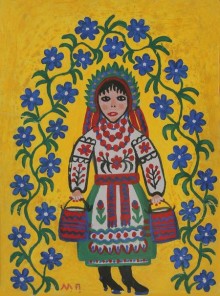The legacy of this folk art master has become the subject of voluminous studies, as art critics strive to unravel the phenomenon of Prymachenko’s paintings, which fascinated people of different generations despite their seeming naivety. Each picture can be viewed for hours on end, for one can always find something magnetic, philosophical and so warm in it. Prymachenko’s works were admired by legendary Pablo Picasso and Marc Chagall, and famous Ukrainian painter Mykola Hlushchenko said: “She embodies the culture of our people.”
During her long life (she lived to be 88), the legendary master created about 5,000 works. Her legacy is preserved in the Museum of Ukrainian Decorative Folk Art, National Museum of Folk Architecture and Life, Zaporizhia Art Museum and local private collections, and the Taras Shevchenko National Museum.
The exhibition which has recently opened at the Shevchenko Museum is displaying more than 40 works from private collections.
The brilliant artist created her own style, comprising endless variety of decorative, ornamental, landscape, and genre compositions. They revealed the beauty, love, and goodness which lived in Prymachenko’s soul. For example, flowers, which she painted bright, decorative, and unusual in form and color, served to create aesthetically and philosophically generalized interpretation of the man-universe relationship, as the artist elevated them to the level of miracle. The image of the bird, an eternal personification of goodness and happiness, is shown to us in this aspect as well. It symbolizes the people’s desire to live in peace, harmony, and love... However, a special place in Prymachenko’s legacy is firmly occupied by decorative panels depicting fantastic creatures and beasts. These are unique creations, in which the artist’s imagination reaches the heights of allegory.
Over time, the paintings’ typical size changed. From small transparent watercolors of the 1930s the master turned to monumental panels and thick saturated colors of gouache, as exemplified by her brilliant series “Cheering Up the People,” created in the 1960s. It brought Prymachenko the Ukrainian SSR’s Shevchenko Prize in 1966 (the award now known as the Shevchenko National Prize of Ukraine).
During her long artistic career, Prymachenko created hundreds of scene and ornamental compositions. Her artistic manner is unique in its use of a range of sun-bright combinations of colors, the power of their emotional impact, the philosophical richness of her works, as well as the originality of composition solutions.
Small texts, including poems, songs or wishes that she placed on the back of the sheets, form an integral part of the artist’s creative works. Sometimes, it is they that reveal the artistically significant meaning of this or that work.
Prymachenko worked into her dying days, leaving us an invaluable legacy that makes the viewer to think and leads them into the special world – the deep, poetic fairy-tale kingdom with its mysteries and revelations. She said: “I paint sunny flowers because I love people and create my works to cheer the people up, to make them happy, so that all nations love each other, and live like flowers all over the planet...”
“Our museum has been working on project ‘Our Time – Our Space’ for several years. It includes annual exhibitions. The project was invented by director of Kyiv publishing house Sofia-A, art collector Maksym Melnyk (he is a co-organizer of the ongoing exhibition of Prymachenko’s works),” sector head of the museum’s exhibition department Liudmyla Davydovska told The Day. “The feature of this exhibition is presenting works from private collections, which are displayed for the first time. Three collectors – Mykhailo Kuchirka, Maksym Melnyk, and Petro Bahrii – brought their treasures to it. One can see here more than 40 works by Prymachenko, including 18 painted plates and one piece of embroidery. We have supplemented the exhibition with some pictures from our own collection. One of the works dates to 1940, it is the earliest of those put on display at the exhibition, and its title is Sea Fortune-Tellers.”








